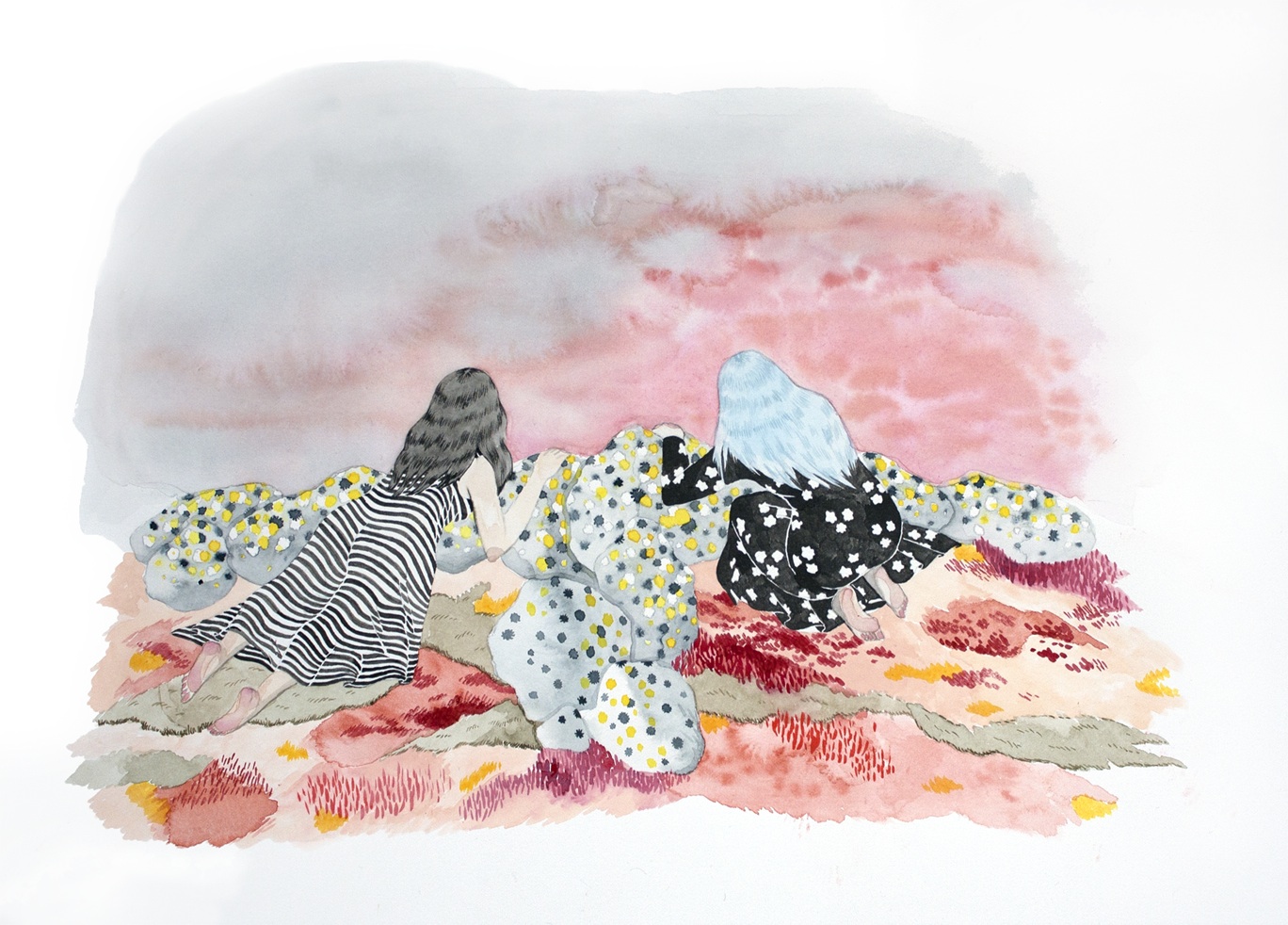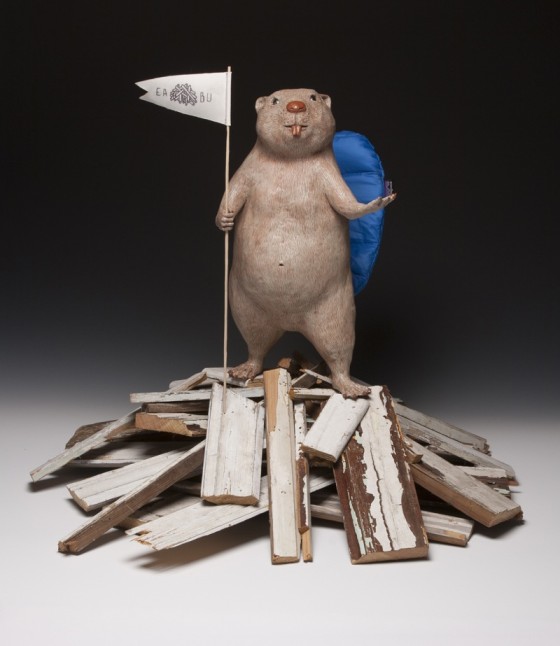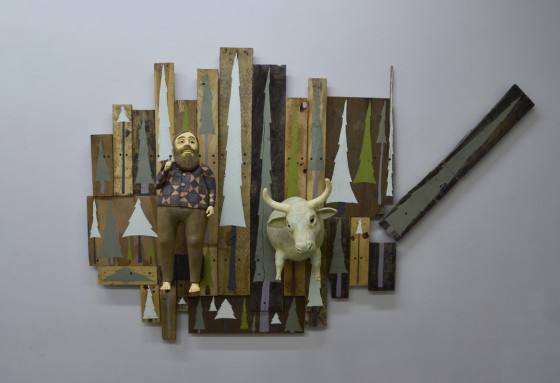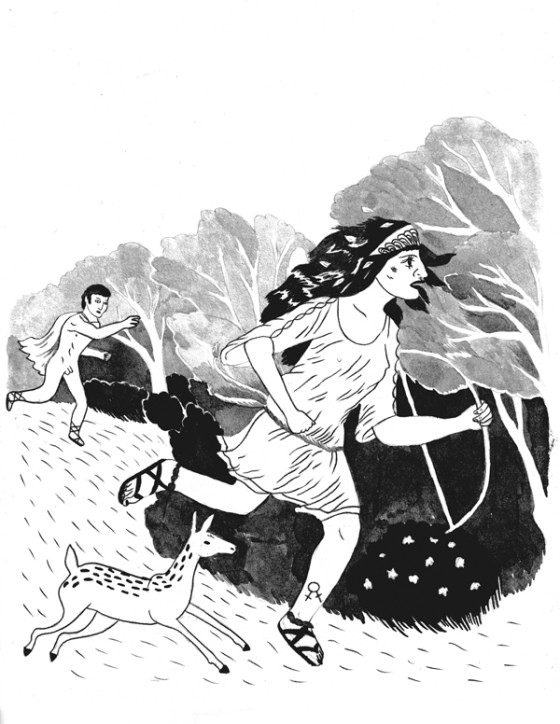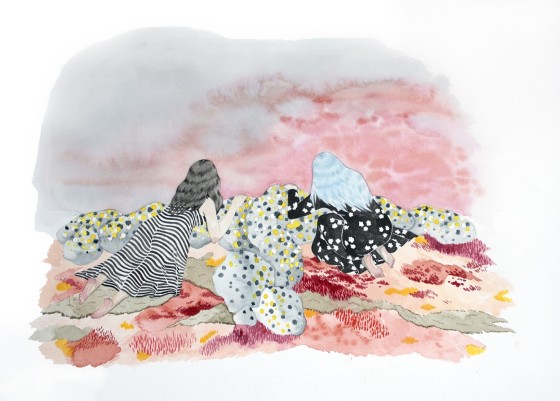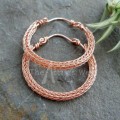A while back we talked about different funding options for artists as part of our Art and Money blog series. One of the options we mentioned was ‘crowdfunding’. You might be familiar with this term, as it has become a very popular means of financing for independent films, small businesses etc. Even celebrities are getting in on the act. Visual arts is surprisingly under-represented or talked about in the arena (although it is definitely on the rise), so we’re here to look at the benefits of crowdfunding for artists in a little more depth.
‘In the Crowd’ by Mark Mitchell
What is Crowd Funding?
The fundamentals of crowdfunding are simple – lots of people pledge small amounts of money to a project they like, often in return for some small token from that project. For example, the rewards could range from a mention and a thank you on your website for donations under £5, to an original painting for donations over £500. How crowdfunding websites work vary, but there are several general rules that apply:
- They are usually free to join, set up a profile, and list your project
- They charge a commission / percentage of the money donated (varies between websites)
- Many operate an all or nothing rule i.e. if you don’t reach your target, you don’t get any of the donations. This is to avoid projects being underfunded, and thereby letting down the people who have donated to the project and potentially not seeing the full potential being delivered
- No money is released to you until the project has reached its goal
- Donors can cancel their pledges if they change their mind
- If your target is reached, you must fulfil the contract of your agreement. If your project doesn’t succeed and you are unable to deliver, you may have to pay people back
- Most sites allow you to go over your target amount
What are some popular crowdfunding websites?
Here are a list of a few example platforms and what their specialist areas are:
- Kickstarter – Specialise in creative projects and probably the best known crowdfunding platform. UK, US, and Canada only.
- People fund it – UK based, specialising in ‘Food, energy, health, environmental, community, recreation, tech or creative.’ So pretty much anything!
- www.sponsume.com – Worldwide. Artistic and entrepreneurial projects.
- www.pozible.co.uk – Used to be solely creative projects, now they are open to all projects with a clear outcome
- www.indiegogo.com Varied project categories, no ‘all or nothing’ policy (so even if you don’t reach your target, you still get whatever is donated so far)
How can it work for artists?
Unlike other funding options (such as applying for artist briefs, writing grant applications, submitting to competitions etc.), one benefit to crowdfunding is that you are in total control of all creative decisions. All copyright remains with you, as you are not selling any intellectual rights. It also allows for total creative freedom in your ideas and ambitions, which often may be restricted to specific themes in other methods of funding. So, if you really believe in your idea and think others will too, but can’t find the right grant opportunity that will tie in with your work, crowdfunding could be a great option.
Also, as we’re sure you’re aware, arts funding in the UK has been drastically reduced in many areas, and with more and more artists applying for opportunities, competition is getting even tougher. Crowdfunding is a chance to take your business into your own hands, and to create your own opportunity, rather than waiting for the right one to come along.
Top tips
Here are the most important things to remember when putting together your project – take your time to get all of these things right. You really want to make your first attempt a good one, as you’ll be utilising valuable contacts who may not be interested a second time around, so consideration and attention to detail are key.
- Budget. perhaps the most important factor in your project. Get your budget wrong, and it’s likely other things will fall apart around it. You need to think very carefully about how much money you actually need, whether you’ll need to employ other people, if you need to travel, etc. Also, if you are providing rewards for donations, you’ll need to factor that into your budget too.
- Choose the best platform for your needs. See examples above as a starting point, but do your research.
- Research other successful campaigns. A great way to do this is to browse the ‘successful projects’ section on each crowdfunding website, as they will give good examples of how to make the most of your campaign
- Be clear about your intentions. Remember that a lot of your investors may not be art-minded people, so make sure you avoid the art waffle. Be clear and concise in describing what your project is about.
- Engage your audience. As well as clarity, engaging content is equally important. You need to present a compelling and inspiring pitch in order to attract the right people. Having a story behind what you’re doing helps people to connect with what you’re trying to achieve.
- Be realistic with your goals. Can you really achieve your ideas with financial target you’ve set? Do you really have time to deliver on the rewards you’ve promised?
- Be Patient. Don’t post your project until it is totally ready. This is a business pitch essentially, so it needs to be perfect. Get some outside advice if you can.
- Share, share, share. Ah, good old social media, what would we do without it? A key tip – start a bit of hype before your campaign actually launches. That way, people will already be interested in your idea and have an understanding of your goals and ability to succeed with other projects.
- Meet people. Take time to build interest in your project. Get to know people, network, build support through face-to-face interaction.
- Make it your aim to get featured. Getting featured by your chosen platform can make a huge difference to how much exposure your project gets. Featured projects tend to be things that are popular, or just what they like at the time. As this can be subjective, it can be hard to get featured. But by taking time to go the extra mile with your idea and pitch before jumping in with the launch, you’re more likely to strike a chord with whoever selects featured projects.
- Make a clever video. It doesn’t need to be high budget, but a short film that captures attention in a creative way can add great value and substance to your idea. Here’s a nice example by artist Jeff Sojka for his successful project ‘European Painting Adventure.’
- Contact the press. Try to go for high quality, well-fitted publications. Smaller magazines and blogs might be more relevant to you than larger media companies, as they can be more targeted to your audience. Sending emails is fine, but it helps if you contact people you’ve met and have built relationships with in the past. If you don’t know anyone, cold emails can still be successful, but be prepared to send out hundreds and only hear back from a tiny minority, if any.
- Rewards. We talked about offering rewards for donations above. Be prepared to alter the rewards as your project develops, add extra on demand, note if there’s an unmet need. Rewards should always be relevant to your work and the project.
- Testimonials. Remember how we talked about how customer testimonials can improve artwork sales? It’s the same principle for crowdfunding… and if you’ve got any celebrity friends, even better!
Case Studies
It’s fair enough us giving you advice, but you want to hear it from the horse’s mouth, right?! We interviewed 2 artists, Jeffrey Sinchich and Tobin Louise Reimer, who have both used crowdfunding as a way to fulfil a project or period of research. Although both artists happen to have used IndieGoGo in this instance, we should be clear that we are not saying this is the best or most popular platform – as mentioned above, all of the available options have their upsides and downsides. However in this situation it seems to have been the best choice for the artists involved. So here is some really valuable, first hand advice from creators of successful and exciting projects…
Jeffrey Sincich
http://www.jeffreysincich.com/
1. Please give us a little introduction about you, and an overview of your crowdfunding project
I am a ceramic and mixed media artist working out of St. Petersburg, FL. In my senior year of undergrad at the University of Florida I applied for the Regina Brown Travel Grant from NCECA, a national educational ceramic conference. I wanted to complete a self-supported bicycle tour from Portland, OR to San Francisco, CA to do research on the tourism, people, culture and landscape of that region. My work at the time was dealing with tourism, travel and folklore of unknown (to me) places. As an avid cyclist, I realized that riding my bicycle down the coast through new and exciting places would provide me with a rich and rewarding experience and a unique opportunity to meet and interact with the local people and culture.
Though the grant was well funded, I still needed just under $1000 dollars to help with travel costs and equipment. I decided to use a crowdfunding program to help raise the rest of the money I needed to make this project happen.
2. You used IndieGoGo to launch your project, what made you choose this platform?
I chose IndieGoGo because they did not have any requirements for what you were using the project money for. Since this was an open-ended project with several possible outcomes, it did not have a concrete goal to accomplish at the end. The other site I considered was Kickstarter. They did, however, require a clear end with something produced as a result. Since my project was for research and inspiration, I felt it did not fulfil this requirement, so I chose IndieGoGo.
3. What inspired you to use crowdfunding to make your project happen?
I knew I had to get more funding to make the project happen but did not want to ask family and friends to donate money outright. I had heard about crowdfunding sites and even backed some of them myself. I knew it was the way to go because in return for the donations, the project starter gives rewards in return based on the monetary value. I decided to make the rewards for my campaign deal with the project itself. I sent postcards from the road, a souvenir from the trip or a handmade ceramic cup I made based on the trip after I finished. This way, the people who helped fund it were part of the project and gave me another way to interact with it.
4. How did you market the project?
I mainly used Facebook to promote my project. I would update with how much I had made so far and how much more I needed. I sent a few emails as well and used the UF Ceramics listserv to get the word out. Some people also promoted the project on their blogs and websites out of the kindness of their hearts, which was much appreciated.
5. How easy or difficult was the process, were you surprised by the response?
The project was pretty simple and straightforward. It was fun to set up and make it part of the project itself. I was not sure if it would work or not, and was surprised when I surpassed my goal by almost $100. It was great to see how much my friends, family and ceramic community supported me.
6. What do you think are the fundamental elements of a successful crowdfunding proposal?
Keep it simple and honest. If you truly believe in the project the process will come easily and naturally, and it won’t be a stretch to make it seem worth funding. Make sure you have your project completely planned out and make your description is clear and relatable. People want to feel like they are supporting something that will actually happen and help the person accomplish something.
As for the rewards, keep them simple as well. Postcards are perfect for smaller donations because they are inexpensive, easy to get, are always fun to receive and make the person feel involved in the project as it is happening. Get creative and make sure the rewards are unique to the project and interesting. They should be easy to get and cost-effective as well.
Be honest with yourself when setting your goal. Make sure you are only asking for the amount of money you really need. Do not overshoot your goal and take advantage of the campaign. Be sure to account for the cut that the site takes and for the cost of the rewards.
8. How did the project outcome go? Did it make a difference knowing that it had been made possible through crowdfunding?
The project was 110% successful with an abundance of funding. Knowing that my friends, family and community helped support the project made it more worthwhile. It also gave me a new motivation knowing that I was doing the project for them as well as myself.
9. Do you have any advice for other artists out there thinking of using crowdfunding?
Make sure your project is unique and will capture people’s interest. There are a ton of other projects out there that need funding, so it is important that yours stands out! Stay honest and keep it simple. Good luck!
—–
Tobin Louise Reimer
www.TobinLouiseReimer.com, www.tumblr.com/toby-lou
Crowdfunding project
1. Please give us a little introduction about you, and an overview of your crowd-funding project
I’m an artist and illustrator living and working Montreal, Quebec. I graduated from Emily Carr University with a BFA in Visual Arts in 2011. I am originally from Vancouver but moved away last year for a change of scenery.I used Indiegogo to raise money to fund the printing of a zines, prints, and postcards for a large craft fair and my future online store. In return, I offered copies of the zines and original artwork created for the supporter.
2. What made you choose this platform?
I used IndieGoGo because Kickstarter wasn’t available in Canada at the time, and also because it lets you keep the money you raise even if you don’t make your goal.
3. What inspired you to use crowdfunding to make your project happen?
Before my campaign, I had noticed on facebook that Canadian artist Jeff Ladouceur was using IndieGoGo to fund a much larger book printing project. He seems like a cool guy, and I thought that if he could do it, I could do it.
4. How did you market the project?
I had quit facebook earlier in the year, but when I decided to do the project, I reactivated my account and just marketed myself shamelessly. I emailed friends and relatives and other artists I knew and asked them to contribute, despite it making me very uncomfortable.
5. How easy or difficult was the process, were you surprised by the response?
The website is really good in that its very user-friendly and has a lot of helpful suggestions in how to market yourself. Right off the bat I was shocked and amazed at how generous people were. I think I made my goal in a week, and after that people continued to donate. It only took a few hours to set up and then daily promotion on facebook, so not very much work.
6. What do you think are the fundamental elements of a successful crowd-funding proposal?
I think sincerity, enticing incentives, and just shameless self promotion are key. Asking for money makes me, and probably a lot of other people uncomfortable, but I think its often very important thing to be good at as an artist.
7. Would you do anything differently?
I wish I had given myself some constraints on the original piece of art incentive, which is what everyone chose. I ended up feeling a bit swamped with all of the work I had to do because I put a lot of time and love into every one of the pieces I sent out.
8. How did the project outcome go? Did it make a difference knowing that it had been made possible through crowdfunding?
The project went great! I was able to rent a studio with the extra money I made, and continued to make and sell my work at various other zine and book fairs throughout the year. It gave me a lot of freedom to have that financial overhead covered, it felt like the world had given me a gift.I met some really great people at Puces Pop, the craft fair I was funding for here in Montreal, and got in on some great art-trades. It was also a huge relief to not have to worry about funding in the beginning, before I had made any return.It made me feel great because I realized I have a lot of supporters and that people other than my friends like my art.
9. Do you have any advice for other artists out there thinking of using crowd-funding?
If you really believe in yourself and your project, do it! It helped me to try to think of social media as a tool that is there to be used, and not feel dirty about using it. I think sincerity is really important, as well as gratitude. People appreciate those things. Also don’t be shy to ask people for money! And if you don’t believe in yourself, who will?
Great advice from both artists, which we’re sure will be extremely helpful to anyone starting out on a similar venture. If you’re looking for more information on the topic, here are a few recommended further reading links:
crosspromote.it/
KickingItForward.org
http://kickstartyourjourney.
http://www.fourhourworkweek.
We hope this article has been helpful to those who are curious of what crowdfunding has to offer, and how to go about getting started. If you are an artist or creative with crowdfunding experience you’d like to share, please leave a comment at the end of this article, we’d love to hear from you!

